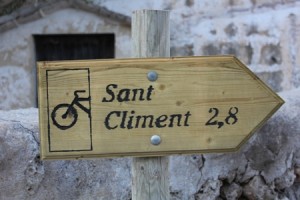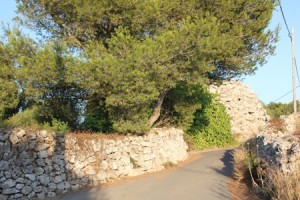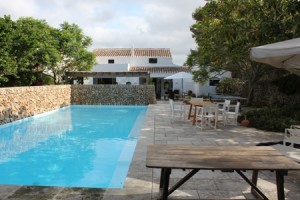More On Menorca, Part III
[Here is what’s right about Menorca]
100+ Beaches
 Within 30 minutes of Mahón are dozens of beautiful rock coves, such as Cala Mitjana, where part of Lina Wertmuller’s Swept Awaywas filmed. For long stretches of sand there’s Santo Tomas or Cala Santo Galdana, which, however, can be crowded, or Son Bou, that has, year after year, the whitest sand.
Within 30 minutes of Mahón are dozens of beautiful rock coves, such as Cala Mitjana, where part of Lina Wertmuller’s Swept Awaywas filmed. For long stretches of sand there’s Santo Tomas or Cala Santo Galdana, which, however, can be crowded, or Son Bou, that has, year after year, the whitest sand.
I favor coves or calas with their small beaches. They are less crowded, and the coves form natural and deep swimming pools. While the larger beaches have bars, it is not difficult to pack a picnic lunch and when you’re tired of swimming just step back into the shadow of pine trees that on the island hover at the water’s edge. People linger till dusk at these beaches, as the Mediterranean summer evenings are long.
Outdoor museum
Menorca’s history, like that of all the Balearics, reaches back into prehistory, as is evidenced by the extraordinary number of well-preserved religious megaliths on the island. Bronze Age Celts erected megalithic monuments as complex as Stonehedge. More than 100 stone burial sites, altars and astronomical observatories are scattered across the southern coast. The best example is on a back road just beyond Binicalaf. You’ll see signs for it. Because of these wonderful ancient sites, I’ve often had the feeling of being in an open-air archaeological museum while driving along the southern coast of the island.
number of well-preserved religious megaliths on the island. Bronze Age Celts erected megalithic monuments as complex as Stonehedge. More than 100 stone burial sites, altars and astronomical observatories are scattered across the southern coast. The best example is on a back road just beyond Binicalaf. You’ll see signs for it. Because of these wonderful ancient sites, I’ve often had the feeling of being in an open-air archaeological museum while driving along the southern coast of the island.
Among the best is Trepuco. This taula, one of theh largest on the island, was excavated from 1928 to 1930 by scholars from Cambridge. It’s dated from around the mid 1st century B.C. The most spectacular ensemble of that era is the Talati de Dalt. This megalithic settlement has a taula, a talayot, and underground caves. The best-preserved talayot is the Torrellonet. See them all!
Other towns
Across the length of the island — forty-five minutes from Mahón —is Ciudadela, the second largest city and the ecclesiastical capital of Menorca. Ciudadela, which means fortress in Menorquin, was a Phoenician city. It has, however, some typical Catalan architecture from the 15th and 16th centuries, as well as Italian and English buildings of more recent vintage. The city was constructed out of stone — notably limestone — and it has a reserve about it that is reminiscent of an elderly, aristocratic Spanish woman.
Go to Ciudadela for no other reason than to have a harbor-side lunch at Casa Manolo. Go early and made a reservation — this outdoor restaurant is very popular. Manolo is perfect for boiled crayfish, lobster, fried quid, mussels marinated in sherry, baked oysters or claims and all sorts of grilled white fish. For dessert (here and everywhere else on the island) there’s Spanish fruits — oranges, lemons, or pineapple — all stuffed with orange, lemon or pineapple ice cream. (Lemon is my favorite
Fornells
North on the island, and at the other side of a high woodland road, is the quiet village of Fornells and other waterside restaurant, Es Pla (Telf: 971. 37. 66.550). But Es Pla is no ordinary restaurant. It is a favorite of King Carlos of Spain who regularly visits this village and wonderful harbor restaurant. The specialty here is calderate de langosta, a mountain of crustaceans toppling from a bowl of lobster broth. After lunch take in the nearby spectacular caves of Cavallería.
Cala’n Porter
Cala’n Porter, which is a British holiday location, doesn’t have much to offer except for the discotheque, Cova d’en Xoroi which is carved out of megalithic caves and clings to the side of a cliff. Legend has it that the caves, perched high up on a steep cliff, were once the secret hideout of a Berber pirate who was washed ashore on Menorca. Using the caves as a refuge, he stole food, goods, and then a young girl — who bore him children — from the town of Alayor. He was finally caught when the island experienced a rare snowfall and armed farmers tracked him to the unknown caves — which are now home to the discotheque. Here, overlooking the sea, you can dance under the light of the full moon.
Near by is the town of Mercadal, which is at the foot of the highest spot on the island, Monte Torro (357m). This former home of a monastery gives a breathtaking view of the entire island. The church itself is built in the Ionic-Byzanthinian style.
South of Mahón, and beyond Es Castell, is Sant Luis, a small village founded by the French, who were on Menorca for a short period during the 18th century. There are several white sand beaches here: Cala Alcaufar, Cala d’es Rafalet, and Punta Prima, all now surrounded by urbanization.
Or perhaps, you just want to stay home and sit by the pool. Either way, in Menorca you’ll have a great time.
